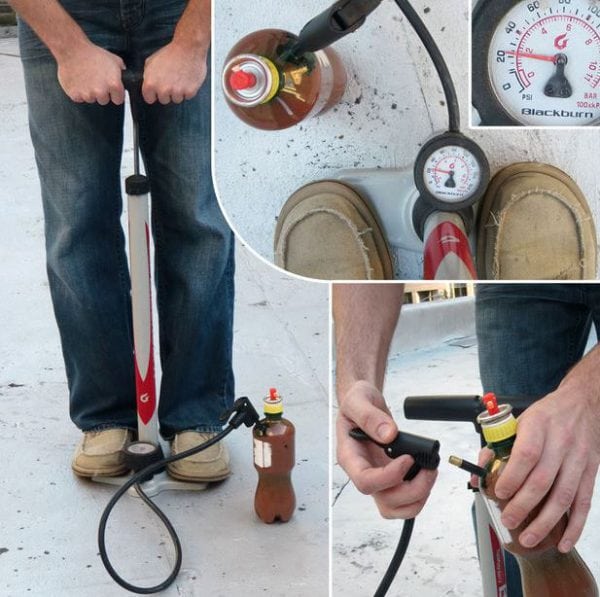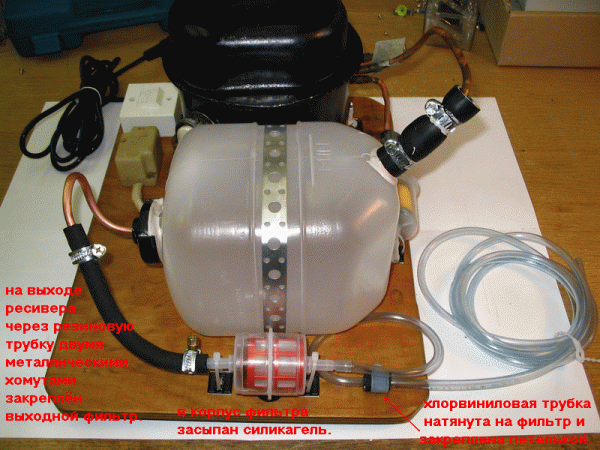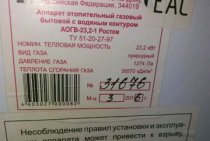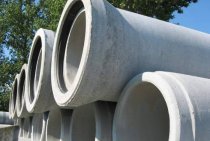Foam gun
Before you start using the foam can, it must be thoroughly shaken so that everything contained in it turns into a homogeneous mass. Usually, a foam gun specially designed for this purpose is used for installation. After the canister is shaken, it opens up and attaches to the gun upside down. It is necessary that the cylinder be in this position throughout the entire operation, otherwise, the gas that displaces the mounting foam, being much lighter than other components, can exit on its own.
By using a gun, you can reduce the time during which the foam is applied, facilitate the dosage of its portions, and also work using only one hand. But it also has disadvantages. It is actually convenient to use when you need to fill gaps with foam. But the possibilities of using polyurethane foam are not limited only to this.
Professional foam sprayers
During professional work, industrial mounting foam is used for thermal insulation of roofs, walls, and pipes. Using special equipment, a polyurethane foam coating is created that can be applied to almost all types of materials - wood, glass, concrete, metal, paint and brick. Polyurethane foam insulation is distinguished by such unique qualities as: durability, minimum thermal conductivity, low labor costs, the possibility of acoustic insulation. In addition, polyurethane spraying is environmentally friendly, resistant to microorganisms, rodents, as well as aggressive environments and root germination.
I would like to emphasize once again that polyurethane foam spraying has always been carried out using special installations, and this was at the level of construction work that only professional workers should perform. Non-professionals who have at their disposal only a foam gun designed to apply polyurethane foam should not be present here.
It will be quite natural to turn to professional workers when it comes to large areas. But if the amount of work is small, then it would be more preferable for many to do it on their own. The problem can now be solved thanks to the fact that a new device has appeared that is designed to work with material such as polyurethane foam. The principle of its operation is similar to a spray gun: what is contained in the cylinder is sprayed onto the surface with an even layer of the desired thickness, which can be of absolutely any configuration.
The purpose of the new foam sprayer is to work at a high professional level. It is attached to the cylinder using a threaded adapter. During screwing in, the balloon outlet is pressed against the spray adapter, which causes the internal valve to open. Under the pressure created by the propellant, the foam opens the ball check valve and passes into the atomizer. The purpose of this valve is to prevent material from escaping the internal spray channel, as well as the ingress of moisture into it during a canister change.
The amount of foam that enters the crushing zone with an air jet is regulated using a locking needle. Mounting foam enters the hole located in the center, and air is supplied through the annular slot, coaxial to the central hole, which is sprayed. There are additional holes on the spray head, which are located diametrically, their purpose is to change the shape of the torch.During the supply of air to them, the torch takes an elliptical shape.
In order to work with this device, it is not at all necessary to be a highly qualified specialist. It is just as easy to use as the gun that everyone is used to. Thus, the use of mounting foam for soundproofing and thermal insulation purposes becomes possible even for non-professionals, and repair work, for example, thermal insulation of a garage, balcony, cellar, basement, is now within the reach of almost everyone.
Making a spray gun for powder paint
Making a powder paint spray gun is not an easy task that requires professional skills and knowledge in the field of electricity. A common airbrush manufacturing technology includes the following tasks:
- Assemble the electrical module. For this, the core is formed from a piece of plastic water pipe and a wire wound around it with a ferrite element. This module is placed in a plastic vessel and filled with paraffin.
- Collect pistol. An electric core is mounted in a plastic tee, while it must fit very tightly into it. The walls from the inside must be treated with glue to ensure the stability of the mechanism. All electrical wires are brought out through the lower holes, which are sealed with paraffin, and the exposed core is covered with a casing.
- Connect the structure to the paint tank. A hole is drilled on the tee, where the tank is inserted, while the flow of paint is regulated by a rubber trigger.
- Separate the wires and close them on the power supply, after which you can start testing and filling the apparatus with powder paint.
Airbrush from a vacuum cleaner
If it is planned to paint walls or ceilings in a large room, then working with a manual home-made sprayer will be quite problematic. In this case, you can try and make an apparatus with an automated air supply. To do this, you need a compressor from the refrigerator or an old vacuum cleaner. Units made from a refrigerator or vacuum cleaner compressor do an excellent job with a water-based composition, but are not suitable for powder paint.
Old Soviet vacuum cleaners have an advantage over modern technology in that their design involved connecting a hose not only to the inlet, but also to the outlet, and they could function both for “blowing” and “blowing”. The models presented on the modern market do not have such capabilities.
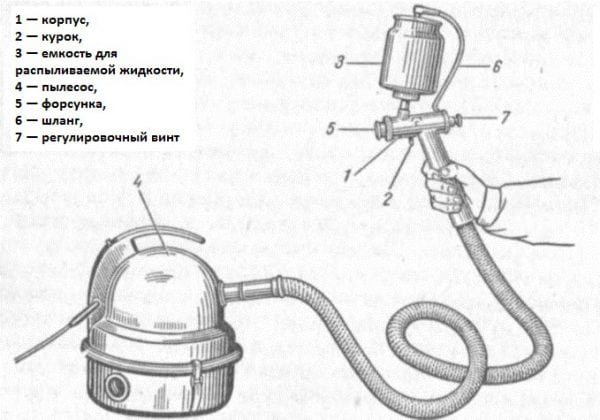
If the use of the vacuum cleaner is no longer planned, then the direction of the thrust can be changed in it, in some cases it will be enough to change the poles of the terminals that are connected to the stator and rotor. After that, it is necessary to carry out several operations that will allow you to fully use the old unit as an electric spray gun for painting:
- Pick up a bottle made of plastic or glass with a wide neck (at least 5 cm in diameter and up to 2 liters in volume).
- Cut out a cork from the foam that fits the size of the neck of the bottle. The cork should have a rectangular ledge that allows you to insert a tube from a ballpoint pen or dropper into the hole at a right angle.
- Make holes and insert tubes, one of which will ensure the flow of paint, and the second will supply compressed air.
- Make another auxiliary hole in the cork through which air will pass into the bottle, and with a decrease in the volume of paint in a tightly closed vessel, a vacuum will occur.
- Cut another foam plug that will combine the paint sprayer and the vacuum cleaner hose into a single system.
How to flush a foam gun
2 solvent syringes are enough to flush the foam from the gun.The cost of a cylinder cleaner for a pistol is about 200 rubles. The bottle is enough for only 2-3 washes. The bad thing is that the balloon constantly flows, "poisons". The cost of a non-tricky device is about 5 - 10 rubles. A bottle of solvent 646 costs only 50 rubles and will last for a long time.
After work, you need to rinse the gun from the foam. If you do not want to spend money on expensive cleaning products, then there is one way that is suitable for this.
We cut off the old balloon from under the foam. Now we clean the remnants of the dried foam. We need a cap - the top of the bottle. You just need to break off the valve from the inside of the cover. We take a metal rod and push it down with a hammer.
Remove the rod with pliers. The tube must remain in the lid. It was the most difficult process. Now it remains only to glue the 20 ml syringe. It will fit snugly into the valve and will hold tight. Pour hot glue between cap and syringe. But you can not pour glue. The device is ready after the glue has hardened.
Pour the solvent from above into a foam can, which we will use again. We fasten our device to the gun and begin to rinse. Pour a simple solvent (646) or acetone into the syringe. We press on the rod with the piston and at the same time on the lever (trigger) for adjusting the foam supply on the gun.
Spray gun holder
A simple do-it-yourself spray gun holder can be made from an ordinary plywood sheet about a centimeter thick. For this you need:
- cut a square of 25 x 25 cm from a sheet of plywood, in which a round hole is cut with a jigsaw, the size of which corresponds to the filling tank of the spray gun;
- insert the pistol handle into the groove cut from the edge of the plywood board to the hole;
- install a stand on legs made of wooden blocks, the height of which should be chosen so that there is space below for placing the hose;
- to such a stand, you can additionally make a holder for a filter funnel; for this, aluminum wire is used, which is attached to plywood with screws.
Sprayer from an aerosol can
A manual spray gun from an aerosol can is one of the simplest types of homemade paint sprayer for water-based paint, which is very easy to make from improvised materials. For work, you need to prepare the following items: a plastic bottle, a bicycle inner tube, an aerosol can, for example, from a used deodorant, and a bicycle pump.
Work is performed in the following order:
cut off a nipple with a cover with a diameter of 3 cm from the bicycle chamber;
make a hole in the bottle;
glue a nipple to the inner wall of the bottle, which will perform the function of forcing the air mass;
cut out a spray module with a valve from a can with a hacksaw (the can must be selected so that its size matches the diameter of the cork from a plastic bottle);
attach the valve to the plug by cold welding, while it is important to create an absolutely tight connection, since the structure will function under pressure;
test the apparatus under pressure not higher than 3 atmospheres.
A home-made spray gun from a can works on the principle of an airless spray and perfectly paints the surface both when painting with a water-based composition and when whitewashing with lime.
Refrigerator for the manufacture of airbrush
An electric spray gun made from a compressor from a refrigerator is much quieter than a vacuum cleaner and provides significant savings when painting with water-based paint and whitewashing with lime. But making such a device is much more difficult.
- Take an old fire extinguisher, cylinder, canister or other tightly closed container as a receiver.
- Remove the compressor and the starting relay; for this, the copper tubes are bitten or sawn off with a hacksaw.
- Turn on the power to determine which tube is supplying pressurized air.
- Attach a car gasoline filter to the tube that sucks in air with a sealant or hose, which will protect the structure from dust.
- Connect the air injection tube with two gasoline hoses to the receiver. For this, fittings fixed with sealant are used.
- Install a diesel filter, which can be purchased at an auto parts store, on the receiver outlet. The filter eliminates excess moisture in the incoming air and improves the quality of the airbrush.
- Fix the compressor and receiver on a solid base, for example, on a board. After that, you can turn on the sprayer and start the painting process.
The manufactured spray gun can be equally effectively used both for painting with water-based paint and for whitewashing with lime.
conclusions
Thus, making a spray gun with your own hands is a doable task. For more complex painting processes and frequent use, it is advisable to make a powerful electric spray gun from a compressor - such a unit is not inferior in its performance to ready-made models. And for small one-time works on painting with water-based paint, a simple spray from a pen or aerosol can is quite suitable.
Thus, having a material with unique properties available to solve a huge range of building problems, we are still left with these problems one on one, since we are left with almost the only opportunity to use polyurethane foam for mounting windows and doors. And if you need to insulate a balcony, garage, attic or plumbing? Or does the cellar require waterproofing and insulation? If the sound insulation of the wall separating your bedroom from the bedroom of your neighbors does not stand up to criticism, and the footage of the apartment does not at all provide for the loss of 15-20 cm of space along the wall to create intimacy? You can, of course, contact a company that has industrial installations for spraying polyurethane foam, and all problems will be solved. True, you may be unpleasantly surprised by the price: when planning expenses, in this case, the cost of the coverage itself should be increased by 40% - the work of specialists is valued quite expensively.
We are pleased to offer you another solution: a foam sprayer, ideal for the needs of individual construction and renovation. Compressed air is used to spray foam, so a compressor is needed. The handle of the foam sprayer has a fitting through which compressed air is supplied to the annular slot located in the spray formation zone. Mounting foam is also supplied there from a professional cylinder attached to the sprayer using a threaded adapter located on top, just like in a conventional gun.
The sprayer is equipped with a non-return ball valve that prevents foam from exiting the sprayer through the adapter when changing the bottle and atmospheric moisture from entering inside, which can lead to the formation of polyurethane directly inside the foam channel. The supply of foam to the place of spray is regulated by a shut-off needle. On the spray head itself there are additional, diametrically located holes, the air supply to which is regulated by screws on the body. Thanks to these holes, it is possible to change the shape of the spray cone to an elliptical one, which makes it possible to spray large surface areas at once. From one cylinder of professional mounting foam with a declared volume of 50 - 70 liters, using a foam sprayer, you can get a heat-insulating layer 5 - 7 centimeters thick on one square meter of the surface.
Just? Very simple! How easy is this sprayer to use? It is held with one hand: we adjusted the spray pattern and ... what problems did we have there? Insulate? Let's insulate! Need waterproofing? Let's do it! Provide soundproofing? We will provide! By the way, low-density coatings have the best soundproofing properties, so do not forget to reduce the foam supply - and intimacy is guaranteed!
Now we can use those wonderful properties of polyurethane foam that we talked about earlier: it really holds perfectly on any building material, and thanks to our sprayer, you can apply a coating on surfaces of any configuration, achieve the required thickness and density.
And one more important plus: if you are short of money, having such a sprayer can be cost-effective. You do not need to invest a large amount in repairs at once - it is enough to buy several professional cylinders of polyurethane foam from each salary. And the result will be no worse than when contacting a specialized company
